Chưa có sản phẩm trong giỏ hàng.
Review sản phẩm
Dòng điện cung cấp suốt ngày cho các thiết bị nhỏ không cần kết nối lưới điện
Giới thiệu All-day off-grid power for small devices
Tận hưởng sức mạnh của điện năng từ mặt trời với sản phẩm cung cấp năng lượng cả ngày dành cho các thiết bị nhỏ. Với sản phẩm này, bạn có thể hoàn toàn thoát khỏi mạng lưới điện và sử dụng nguồn năng lượng tái tạo mọi lúc, mọi nơi. Bạn không còn phải lo lắng về việc hết pin hay cắt điện nữa. Hãy trải nghiệm sự tiện lợi và tự do với sản phẩm này ngay hôm nay!
#QueenMobile #SảnPhẩmĐánhGiá #MuaSắm thông minh
Queen Mobile mang đến sự thuận tiện cho cuộc sống hàng ngày của chúng ta với nguồn năng lượng ngoại lưới quanh thế giới đối với các thiết bị nhỏ.
Với sứ mệnh cung cấp nguồn năng lượng 24/7 cho các thiết bị nhỏ, Queen Mobile đã tỏ ra là lựa chọn lý tưởng cho những người muốn sống ngoại lưới và tiếp tục sử dụng điện nhưng không muốn gắn chúng vào điện lưới. Nhờ vào công nghệ tiên tiến, Queen Mobile hiện đã trở thành một trong những công ty hàng đầu trong lĩnh vực này.
Với Queen Mobile, bạn có thể sạc đầy pin điện thoại di động của mình, máy tính bảng, máy nghe nhạc, đèn pin và các thiết bị khác trong thời gian ngắn mà không cần phải lo lắng về việc tìm kiếm nguồn điện. Với dung lượng lớn và hiệu suất cao, Queen Mobile đảm bảo rằng bạn không bao giờ phải gặp phải tình huống cạn pin không ngờ.
Một điều đặc biệt về Queen Mobile là khả năng cung cấp năng lượng từ các nguồn tái tạo như năng lượng mặt trời và gió. Điều này góp phần đáng kể vào việc giảm lượng khí thải carbon và bảo vệ môi trường. Với những thiết bị nhỏ như Queen Mobile, chúng ta có thể cùng nhau có phần đóng góp nhỏ nhưng ý nghĩa vào việc bảo vệ hành tinh đáng sống này.
Ngoài ra, việc mua sản phẩm Queen Mobile cũng đơn giản và thuận tiện. Bạn có thể đặt mua trực tuyến với một số cú nhấp chuột đơn giản và sản phẩm sẽ được chuyển đến tận nhà của bạn. Thậm chí Queen Mobile còn cung cấp chính sách hoàn tiền trong vòng 30 ngày nếu bạn không hài lòng với sản phẩm của họ.
Đánh giá tích cực về sản phẩm Queen Mobile cũng là một yếu tố quan trọng. Khách hàng đã chia sẻ về sức mạnh và sự bền bỉ của Queen Mobile trong cung cấp năng lượng cho các thiết bị của họ. Mọi người đều tỏ ra ấn tượng với hiệu suất và chất lượng của sản phẩm này.
Tóm lại, nếu bạn đang tìm kiếm một nguồn năng lượng ngoại lưới để sử dụng cho các thiết bị nhỏ, Queen Mobile là sự lựa chọn hoàn hảo. Bạn không chỉ có được nguồn điện liên tục 24/7 mà còn đóng góp cho việc bảo vệ môi trường. Mua Queen Mobile ngay hôm nay và trải nghiệm sự thuận tiện và tiết kiệm mà sản phẩm này mang lại!
Mua ngay sản phẩm tại Việt Nam:QUEEN MOBILE chuyên cung cấp điện thoại Iphone, máy tính bảng Ipad, đồng hồ Smartwatch và các phụ kiện APPLE và các giải pháp điện tử và nhà thông minh. Queen Mobile rất hân hạnh được phục vụ quý khách….
_____________________________________________________
Mua #Điện_thoại #iphone #ipad #macbook #samsung #xiaomi #poco #oppo #snapdragon giá tốt, hãy ghé [𝑸𝑼𝑬𝑬𝑵 𝑴𝑶𝑩𝑰𝑳𝑬] ✿ 149 Hòa Bình, phường Hiệp Tân, quận Tân Phú, TP HCM
✿ 402B, Hai Bà Trưng, P Tân Định, Q 1, HCM
✿ 287 đường 3/2 P 10, Q 10, HCM
Hotline (miễn phí) 19003190
Thu cũ đổi mới
Rẻ hơn hoàn tiền
Góp 0%
Thời gian làm việc: 9h – 21h.
KẾT LUẬN
Dự án mang tên “All-day off-grid power for small devices” là một giải pháp đáng kích thích cho việc mua sắm của người tiêu dùng. Dự án này cung cấp nguồn điện năng lượng mặt trời để sử dụng cho các thiết bị nhỏ trong suốt cả ngày mà không cần kết nối với lưới điện.
Người mua có thể tận hưởng sự tự do và thuận tiện khi sử dụng các thiết bị như điện thoại di động, máy tính bảng, đồng hồ thông minh và nhiều thiết bị nhỏ khác mà không cần lo lắng về việc sạc pin. Dự án này sử dụng năng lượng mặt trời, một nguồn tái tạo và xanh, cho phép người dùng tiết kiệm nhiều tiền và thời gian.
Khách hàng có thể cảm nhận sự tiện ích và độ tin cậy trong việc sử dụng các thiết bị nhỏ hàng ngày mà không cần dựa vào nguồn điện lưới. Ngoài ra, dự án còn thúc đẩy lối sống bền vững và giúp bảo vệ môi trường bằng cách giảm lượng khí thải carbon và sử dụng năng lượng tái tạo.
Với “All-day off-grid power for small devices”, người mua có thể tận hưởng cuộc sống hiện đại mà không gặp bất kỳ giới hạn nào về nguồn điện. Dự án này mang lại lợi ích thực sự cho người tiêu dùng và đó là lý do tại sao nó đáng kích thích người mua.
Verdict
If you want a compact, rugged and practical power supply for camping trips or weekends away, the Anker PowerHouse 521 Solar Generator is nigh-on perfect. Combining a decent range of ports, good battery performance, and a 100W solar panel, it could be all you need to keep mobile phones, laptops and even a mini-fridge in business while away from the power. It’s not cheap, but it’s impressively useful.
Pros
- Good range of ports and functions
- Compact and not overly heavy
- Good battery performance
Cons
- Not ideal for AC backup or UPS use
-
A small, solar-charging power bankThis set combines a 256Wh power bank with 100W solar panels, providing modest off-grid power topped up by sunshine -
A good range of ports and functionsBetween the panels and power bank there are plenty of ports, a light, and an excellent display
Introduction
Go to a festival or spend a weekend camping, and within a day, your phone will have run out of charge, and any cool food will be melting.
The Anker 521 Solar Generator is one of a growing range of products designed to help with that. Sold as a set, it combines Anker’s entry-level PowerHouse 521 portable power supply with the Anker 625 solar panel, which is rated at 100 watts (100W).
At £500/$499, it’s a bit risky to take it to a festival, but it’s ideal for most other camping trips – especially if the sun’s shining. The 521 offers a decent range of ports, including a mains plug socket, while the bundled solar panels add two more USB ports for good measure.
Design and features
- Reasonably portable, light and rugged
- Good selection of ports and functions
- Smart, thoughtful design and layout
The Anker PowerHouse 521 is about as compact as mains-capable power banks get. It’s the size of a toaster, and weighs 3.7 kilograms – not bad given it’s full of batteries.
These are lithium iron phosphate (LiFePO4 or LFP), which offer more long-term durability than standard lithium-ion (Li-ion). They’re rated for over 3000 charge cycles: enough to fully charge and drain the 521 daily over more than eight years. Anker says it’s built for 10 years’ use, and backs that up with an impressive five-year warranty.
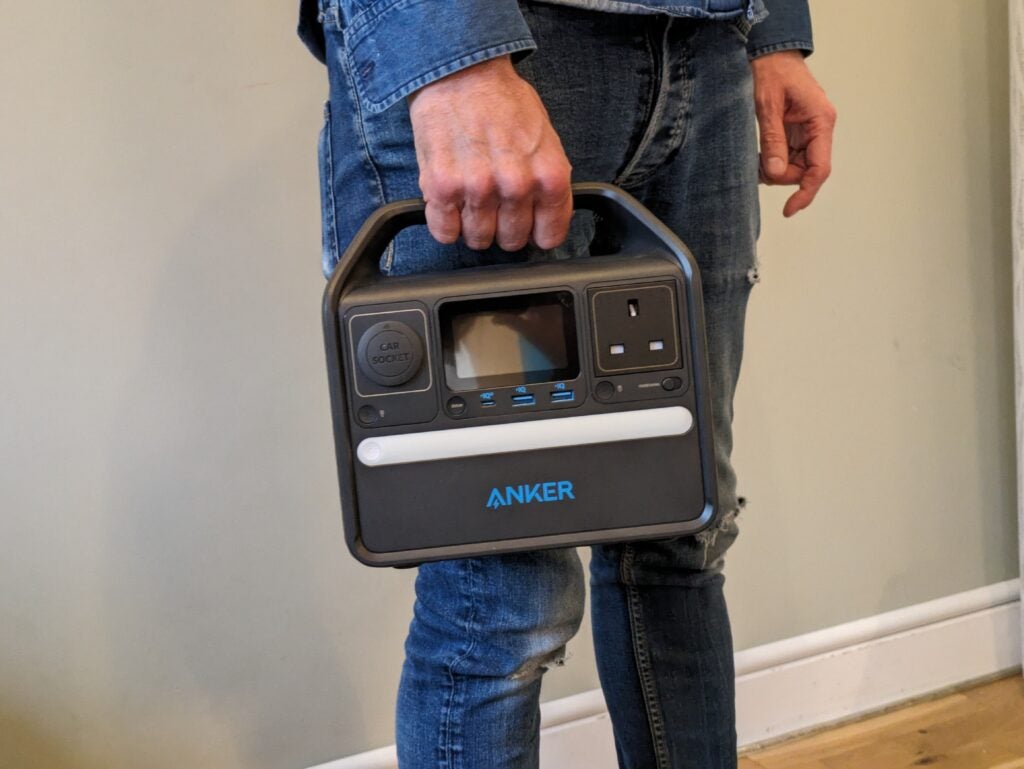
Despite its compact size, the Anker PowerHouse 521 offers two USB-A ports, one USB-C, a 12V car-type (cigarette) port, and a single AC socket. Each USB-A port has a 12W maximum, while the USB-C supports USB Power Delivery (USB PD) up to 60W – enough to power smaller laptops. The car outlet tops out at 120W, while the AC socket only goes up to 200W, which is enough for laptops and other small devices, but not power-hungry gadgets like coffee machines.
You can buy the Anker PowerHouse 521 on its own, but I’m testing it here as the Anker 521 Solar Generator, which bundles the 521 with the Anker 625 Solar Panel. Open the cable pouch on this and you’ll find an additional 12W USB-A socket, and a USB-C port limited to 15W. In both cases, you’ll only get that if the solar panel’s receiving enough sunlight.
The panel itself is split across four sections, which extend to about 1450x470cm, and fold up neatly to about the size of a large carrier bag. At 5.1kg it’s a little on the heavy side if you have to lug it far. On the front, there’s a small target designed to help you align it fully with the sun, but its legs don’t extend to fixed angles as we’ve seen on other panels. In my sheltered garden, they seemed to keep the panel stable from about 75° down to their approximately 35° maximum.

This bundle arrives with a three-metre-long solar cable, which should be enough to reach into a tent or van. My only concern with the panel’s neat, fabric design is that it doesn’t appear to be IP-rated. With that in mind, you might need to look out for rain or dew.
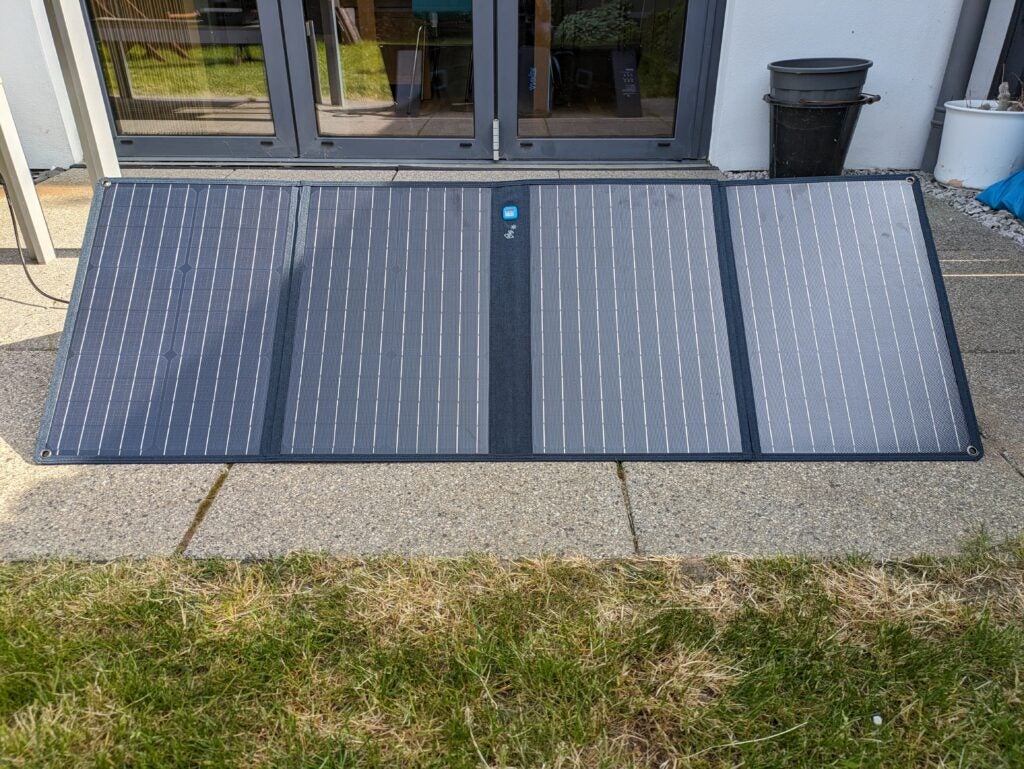
The Anker PowerHouse 521 stores a maximum of 256 watt-hours (Wh) of electricity. In other words, you could theoretically use it to power a 50W laptop for five hours, or a standard PC and monitor for perhaps a bit more than an hour.
Anker has added a few neat features to this power bank. There’s a warm-white reading light that consumes only about 2W, and an excellent display that shows the charge state, the power coming in and going out, and an estimate of how long until the battery is charged or empty, depending on the balance.
Both the car and AC ports have their own power switches. Both have a power-saving feature that shuts them off if there’s a low load, but you can disable this if you’re using important low-power equipment like a CPAP machine.
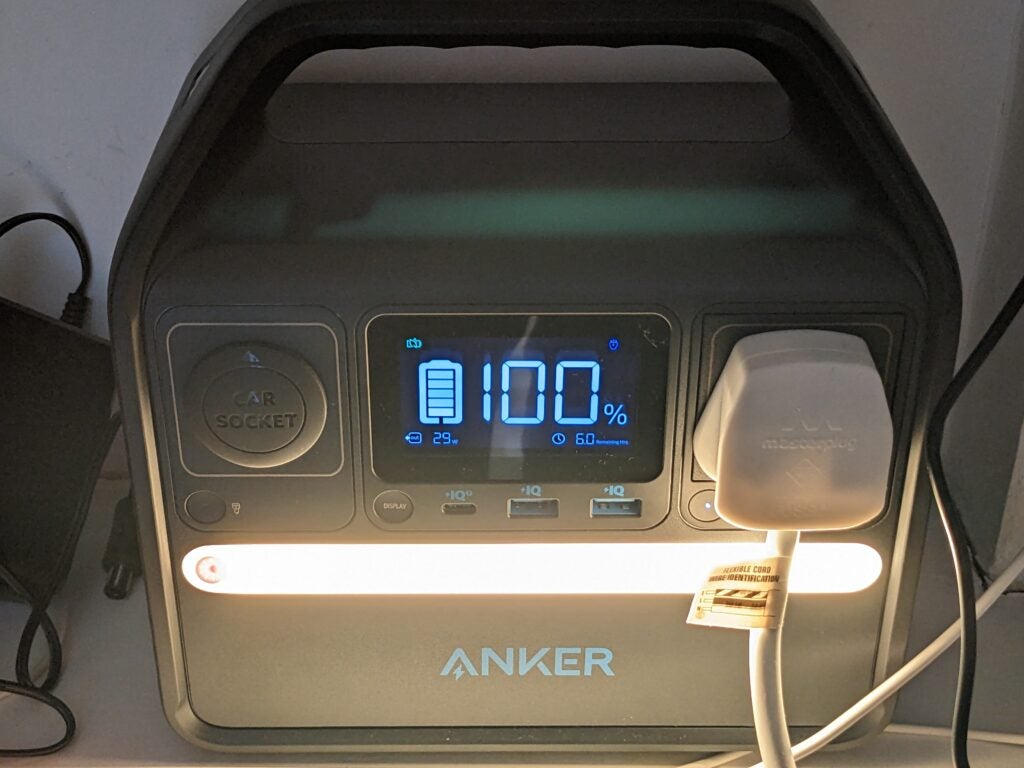
Charging
- Charge from mains, car or the sun
- Maximum 125W input
- Not ideal as a backup
When it comes to charging, the Anker PowerHouse 521 is remarkably versatile. You can connect its supplied 65W power adaptor, car adaptor or solar panels to its rear port, using which it can charge fully in about four hours.
Cleverly, you can also connect a charger to the USB-C port, which will accept up to 60W, bringing the recharge time down to about two and a half hours. It’s a shame you can’t combine more than one of the car, solar and the supplied AC charger, though – they all use the same port.
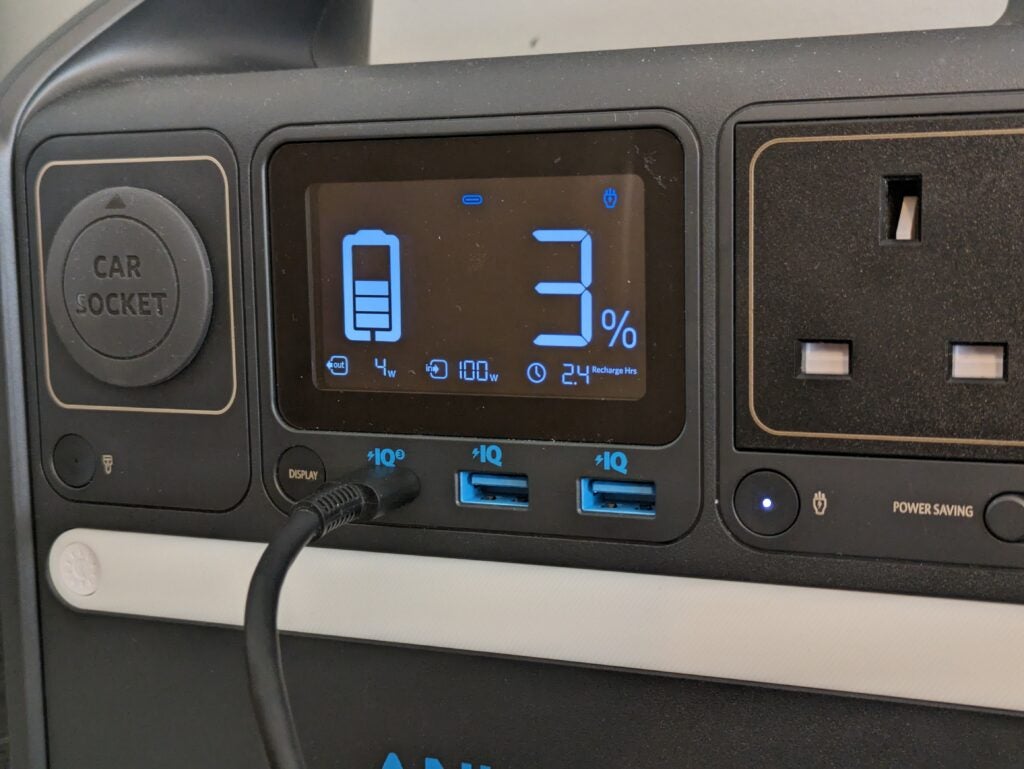
The Anker PowerHouse 521 has enough storage to get low-powered equipment through a short power cut, but it’s not brilliantly suited to providing backup power. Its external AC adaptor means there’s no mains passthrough mode, which would otherwise supply mains power directly to any plugged-in load without needing to be converted to direct current and back. That limits its maximum output, and causes some inefficiency when operating on mains power.
As it is, if the load is greater than the 65W the adaptor can supply (or 125W if you’re also using an additional USB-C charger), it’ll discharge the battery.
The 625 Solar Panel produced a couple of watts just from the diffuse light at 8am, but like all solar panels, it’s at its best in direct sun. Left connected on a sunny day, with the 521 shaded underneath, it was fully charged from empty by 3:15pm, suggesting the panels and power bank are well matched for summer use. That said, if I’d also connected a load – perhaps a 10W mini-fridge – I might have needed to re-align the panels a few times for maximum efficiency.
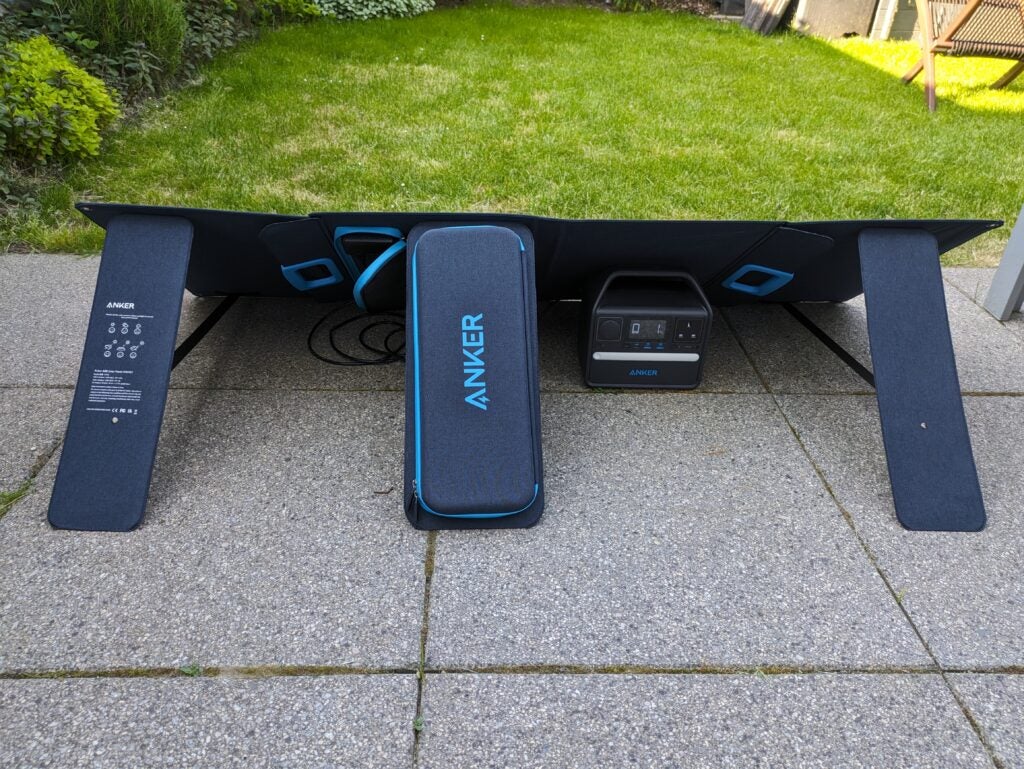
Although the 625 Solar Panel is rated at 100W, the PowerHouse 521 is limited to a 65W solar input. It was easy to hit an indicated 63W, even when the panel wasn’t perfectly aligned to the sun, but that’s the maximum input I recorded during my tests. In ideal conditions it’s enough to fully recharge the 521 in a little over four hours.
Performance
- Stable power output and behaviour
- Reasonable efficiency
- Largely silent on light loads
It was some time before I realised that the PowerHouse 521 was even equipped with a fan. During charging and my light-load tests it was entirely silent, with no obvious buzzing and just a small amount of warmth at the top of its case. This power bank’s 65W AC adaptor has to work quite hard, however, and it can get almost too hot for prolonged handling during charging, or when helping power a heavy load.
I tested the 521 with a constant 33W load from an air purifier. On battery alone it lasted for five and a half hours, having supplied a total of 177Wh, according to my mains power meter. Assuming it consumed the full 256Wh from its battery, that’s a discharge efficiency of 69%. Connected to a heavier load totalling around the 200W maximum this rose to 189Wh (74%). It was during this test that I heard the cooling fan for the first time, working gently at first, then stepping up to a significantly faster speed. It was never harsh or particularly loud.
I measured a total consumption of 279Wh to fully recharge the battery. Again, assuming that this fully filled the battery, that’s an impressive charging efficiency of 92%. My figures give a best round-trip efficiency (charge and discharge) of 68%, meaning less than a third of the mains electricity I stored was lost. I should point out that I only measured the 521’s AC output, which uses an inverter to create alternating mains power, at the cost of a few watts’ power consumption. If you’re only using USB, you’ll get more from each stored charge.
I tested the 521 slightly beyond its rated 200W mains power output. It managed to supply a measured 215W for a few minutes, before shutting itself off. Tested with a much heavier load it shut down instantly. In backup mode, there was no warning when this power bank approached the end of its battery charge and, when it reached it, it shut down. If you’re getting low, you’ll need to keep an eye on the display.
When fully discharged, the Anker PowerHouse 521 won’t provide mains power until it’s been recharging for a few minutes – at an indicated 2%. I found that, if the fans had been running when it ran out of power, they restarted during charging and continued until the battery pack was fully cooled, but they weren’t otherwise needed given the leisurely charge speed.
Taking Anker’s claimed 3000-cycle life and a charge level of 80%, this power bank can store a total of 614 kilowatt-hours (kWh) during its lifetime. Calculated for the price of the Anker PowerHouse 521, that works out at a very competitive 37.6p per kilowatt hour (p/kWh). Factor in the solar panels and it’s 81.4p/kWh.
Latest deals
Should you buy it?
You need off-grid power for small devices: This is an excellent, small solar power bank for phones and light-duty devices, especially in the summer.
You need backup AC power: The Anker PowerHouse 521 is not ideal for providing backup AC power, in most cases.
Final Thoughts
Overall, the Anker PowerHouse 521 is an excellent portable power bundle, providing you aren’t expecting too much. Its modest output and capacity, taken with its lack of bypass mode, mean it’s not suited for backup or emergency mains power in most cases.
If you need something small, with more power, then the Bluetti AC60 is a better choice. Stick to what it’s built for – providing modest off-grid power – and it’s great. The PowerHouse 521 excels with low loads like mobiles, laptops or a mini-fridge, has a handy built-in light, and is rugged and neatly designed. Buy it with the 625 Solar Panel and – on moderately sunny days – you’re likely to outpace your consumption and enjoy indefinite, day-round power.
How we test
We test every battery station we review thoroughly over an extended period of time. We use standard tests to compare features properly. We’ll always tell you what we find. We never, ever, accept money to review a product.
Find out more about how we test in our ethics policy.
We test with a variety of devices to see how long the battery will last.
We test different charging methods to see how quickly the battery can be topped up.
You might like…
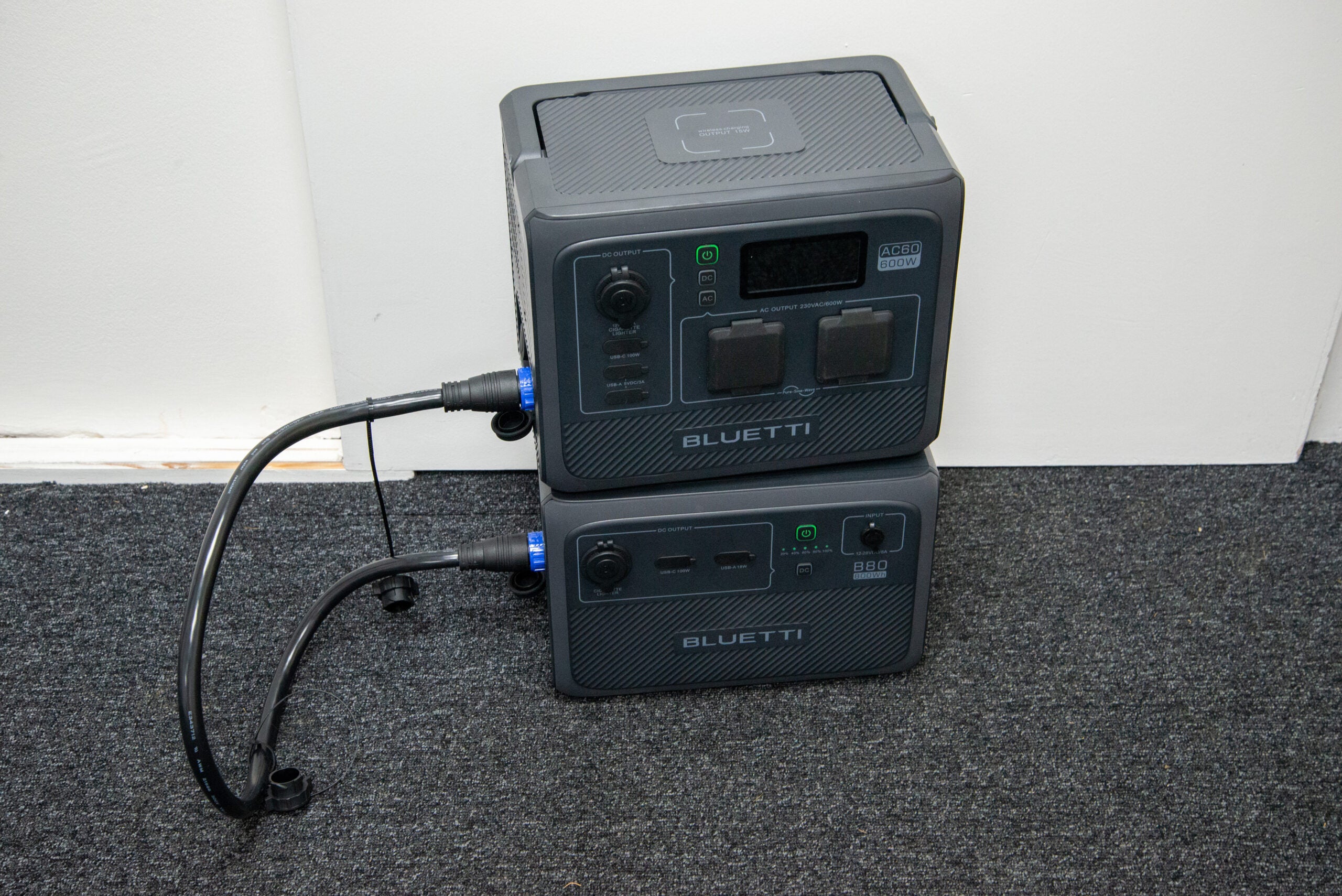
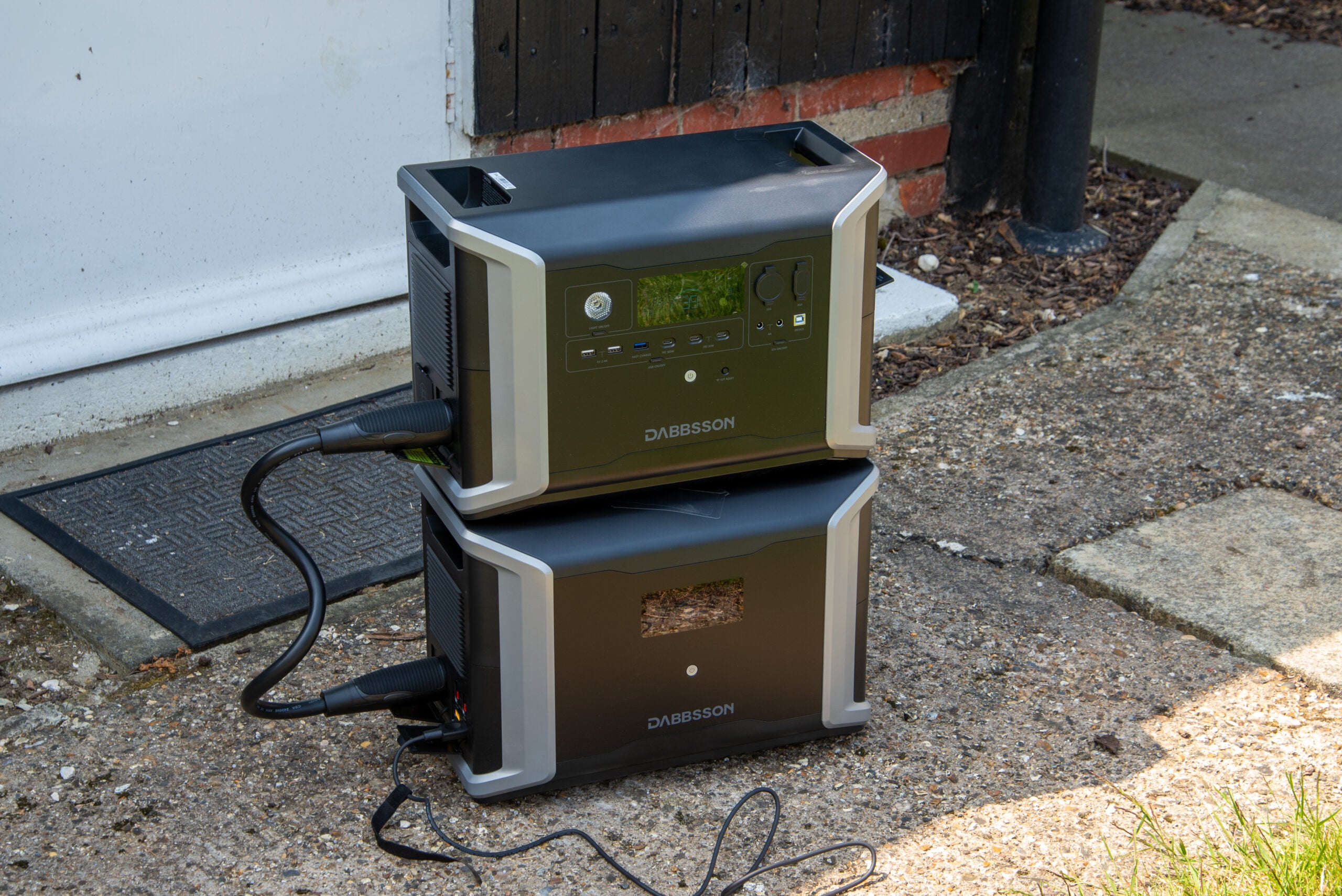
FAQs
Can I power this entirely by the sun?It depends on how sunny the weather, what time of year it is, and how many devices you need to power. If you’re just using a couple of mobile phones and a laptop, you might find you can work off-grid and recharge the battery ready for some night time use. In cloudy weather or during winter, you probably won’t generate enough solar power.
Can I recharge this from my car?Yes. It comes with the required adaptor, and will be full after about four or five hours of driving.
How portable is this bundle?Both the PowerHouse 521 and 625 Solar Panel have handles, and both weigh 5kg or less. A fit person could easily carry them for a couple of hundred metres before getting tired. The 521 is compact, and easy to squeeze into a full boot. The solar panel might be a little trickier to accommodate.
‹UK RRP
USA RRP
EU RRP
CA RRP
AUD RRP
Manufacturer
Quiet Mark Accredited
Battery
Size (Dimensions)
Weight
ASIN
Release Date
First Reviewed Date
Battery type
Battery technology
Battery size
Anker Solar Generator 521
£600
Unavailable
Unavailable
Unavailable
Unavailable
Anker
No
256 Whr
216 x 144 x 211 MM
3.7 KG
B0B9GHM832
2022
21/06/2023
Rechargeable
Lithium-ion
AA


